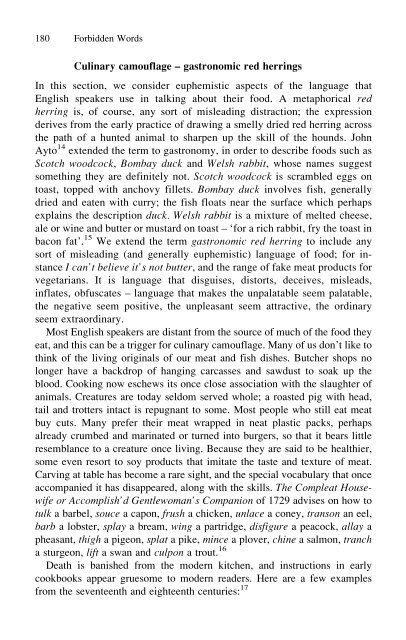Forbidden Words: Taboo and the Censoring of Language
Forbidden Words: Taboo and the Censoring of Language
Forbidden Words: Taboo and the Censoring of Language
Create successful ePaper yourself
Turn your PDF publications into a flip-book with our unique Google optimized e-Paper software.
180 <strong>Forbidden</strong> <strong>Words</strong><br />
Culinary camouflage – gastronomic red herrings<br />
In this section, we consider euphemistic aspects <strong>of</strong> <strong>the</strong> language that<br />
English speakers use in talking about <strong>the</strong>ir food. A metaphorical red<br />
herring is, <strong>of</strong> course, any sort <strong>of</strong> misleading distraction; <strong>the</strong> expression<br />
derives from <strong>the</strong> early practice <strong>of</strong> drawing a smelly dried red herring across<br />
<strong>the</strong> path <strong>of</strong> a hunted animal to sharpen up <strong>the</strong> skill <strong>of</strong> <strong>the</strong> hounds. John<br />
Ayto 14 extended <strong>the</strong> term to gastronomy, in order to describe foods such as<br />
Scotch woodcock, Bombay duck <strong>and</strong> Welsh rabbit, whose names suggest<br />
something <strong>the</strong>y are definitely not. Scotch woodcock is scrambled eggs on<br />
toast, topped with anchovy fillets. Bombay duck involves fish, generally<br />
dried <strong>and</strong> eaten with curry; <strong>the</strong> fish floats near <strong>the</strong> surface which perhaps<br />
explains <strong>the</strong> description duck. Welsh rabbit is a mixture <strong>of</strong> melted cheese,<br />
ale or wine <strong>and</strong> butter or mustard on toast – ‘for a rich rabbit, fry <strong>the</strong> toast in<br />
bacon fat’. 15 We extend <strong>the</strong> term gastronomic red herring to include any<br />
sort <strong>of</strong> misleading (<strong>and</strong> generally euphemistic)language<strong>of</strong>food;forinstance<br />
I can’t believe it’s not butter, <strong>and</strong> <strong>the</strong> range <strong>of</strong> fake meat products for<br />
vegetarians. It is language that disguises, distorts, deceives, misleads,<br />
inflates, obfuscates – language that makes <strong>the</strong> unpalatable seem palatable,<br />
<strong>the</strong> negative seem positive, <strong>the</strong> unpleasant seem attractive, <strong>the</strong> ordinary<br />
seem extraordinary.<br />
Most English speakers are distant from <strong>the</strong> source <strong>of</strong> much <strong>of</strong> <strong>the</strong> food <strong>the</strong>y<br />
eat, <strong>and</strong> this can be a trigger for culinary camouflage. Many <strong>of</strong> us don’t like to<br />
think <strong>of</strong> <strong>the</strong> living originals <strong>of</strong> our meat <strong>and</strong> fish dishes. Butcher shops no<br />
longer have a backdrop <strong>of</strong> hanging carcasses <strong>and</strong> sawdust to soak up <strong>the</strong><br />
blood. Cooking now eschews its once close association with <strong>the</strong> slaughter <strong>of</strong><br />
animals. Creatures are today seldom served whole; a roasted pig with head,<br />
tail <strong>and</strong> trotters intact is repugnant to some. Most people who still eat meat<br />
buy cuts. Many prefer <strong>the</strong>ir meat wrapped in neat plastic packs, perhaps<br />
already crumbed <strong>and</strong> marinated or turned into burgers, so that it bears little<br />
resemblance to a creature once living. Because <strong>the</strong>y are said to be healthier,<br />
some even resort to soy products that imitate <strong>the</strong> taste <strong>and</strong> texture <strong>of</strong> meat.<br />
Carving at table has become a rare sight, <strong>and</strong> <strong>the</strong> special vocabulary that once<br />
accompanied it has disappeared, along with <strong>the</strong> skills. The Compleat Housewife<br />
or Accomplish’d Gentlewoman’s Companion <strong>of</strong> 1729 advises on how to<br />
tulk a barbel, souce a capon, frush a chicken, unlace a coney, transon an eel,<br />
barb a lobster, splay a bream, wing a partridge, disfigure a peacock, allay a<br />
pheasant, thigh a pigeon, splat a pike, mince a plover, chine a salmon, tranch<br />
a sturgeon, lift a swan <strong>and</strong> culpon a trout. 16<br />
Death is banished from <strong>the</strong> modern kitchen, <strong>and</strong> instructions in early<br />
cookbooks appear gruesome to modern readers. Here are a few examples<br />
from <strong>the</strong> seventeenth <strong>and</strong> eighteenth centuries: 17

















